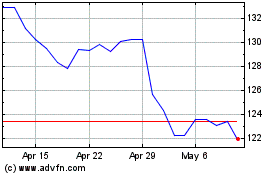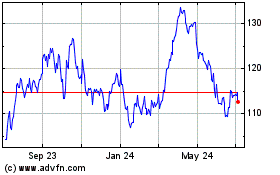CALGARY, Alberta—Crude oil output from some of Canada's largest
producers dwindled on Thursday, affecting global prices, as raging
forest fires led to some reductions in oil sands mining
operations.
While no oil operations have sustained damage from the fires,
many operators curbed output amid evacuations of nonessential
staff, pipeline outages and the risk from encroaching blazes.
That's led to an output reduction of at least 475,000 barrels a
day, or almost one-fifth of Canada's 2.5 million barrels in total
oil sands production. Much of that is imported to crude oil
refineries in the U.S.
The outages are widely expected to be temporary, but they
increased the value of typically heavily discounted Canadian crude
in trading. West Texas Intermediate, the U.S. benchmark, rose 1.2%
to $44.32 a barrel, while the global benchmark Brent rose 0.9%, as
worries about lower supplies from Libya and Nigeria also affected
trading.
Oil prices have been weighed down for almost two years by excess
supply. But production has started to fall in the U.S. and
elsewhere following massive spending cuts by energy companies,
while demand continues to grow. That means the global crude market
is less oversupplied than it was even a few months ago, analysts
say, and producers' capacity to ramp up production has been
reduced.
That makes the market more vulnerable to a shortage if
production is halted in any part of the world.
The amount of daily oil production threatened by the Canadian
fires would be enough to nearly wipe out the world's oversupply,
said Tim Pickering, chief investment officer of Auspice Capital
Advisors, which manages $300 million and an exchange-traded fund
based on the Canadian Crude Index.
"This is the most important issue in oil today," Mr. Pickering
said. "That will put the system back in check really quick."
In addition to Canada, oil traders are currently worried about
lower supplies from Libya due to political unrest and from Nigeria
due to a pipeline outage. Some analysts also warn that Venezuela's
oil production could fall amid the country's struggling economy and
power shortages.
The longer-term impact of the Alberta fire remains unclear, with
some industry officials saying production will likely bounce back
quickly as soon as the fire threat recedes. Others say damage to
infrastructure and from displaced workers could hamper efforts to
ramp up output.
"I expect we'll recover fairly quickly, but it's too early to
say how much damage has been done to equipment and operations in
the town of Fort McMurray," Steve Laut, president of Canadian
Natural Resources Ltd., said on a conference call with analysts.
Mr. Laut said that oil sands output at his company, a major oil and
gas producer, hasn't been affected so far by the disaster.
But the Bank of Nova Scotia said the destruction of property and
loss of production at other oil sands operations could cast a long
shadow. The forest fire fallout could mean "very little" GDP growth
for the overall Canadian economy in the second quarter and that the
damage to infrastructure will slow the recovery in the country's
oil patch, the bank said in a report Thursday.
Western Canadian Select traded at less than $12 a barrel below
WTI, the highest level relative to U.S. prices since July 2015.
The oil-sands facilities aren't directly threatened by the
uncontrolled forest fires, but mandatory evacuations of workers
have affected some operations.
In the latest of a series of plant closures, ConocoPhillips on
Thursday shut down an oil sands site that produced 50,000 barrels a
day and evacuated all staff due to an encroaching fire near the
town of Anzac. That followed a similar move late Wednesday by Nexen
Energy ULC, a subsidiary of Chinese energy giant Cnooc Ltd., to
halt a nearby oil sands operation of 20,000 barrels a day.
ConocoPhillips began evacuating 865 people at its Surmont oil
sands site before dawn Thursday, including 196 displaced local
residents who had been offered shelter, in what a it called a
"precautionary measure."
Two of the biggest oil-sands producers already reduced or halted
production by at least 385,000 barrels a day. Suncor Energy Inc.,
Canada's largest producer, late Wednesday shut down its base mine
operation, consisting of a pair of strip mines and partial
refineries, with a combined capacity of 350,000 barrels a day,
though it had been running closer to 130,000 barrels a day as a
result of routine maintenance.
Suncor also cut output at its 350,000 barrels-a-day Syncrude
mining operation and 203,000 barrels-a-day Firebag well site, but
didn't specify by how much. The Canadian unit of Royal Dutch Shell
PLC shut down its oil sands mines producing 255,000 barrels a
day.
"That's largely being done to allow folks to focus on rendering
aid to the community and emergency response," Lee Tillman, CEO of
Marathon Oil, which holds a stake in the mines, said on a
conference call. "The mines themselves are not under any direct or
immediate threat."
Smaller operators, such as Husky Energy Inc., reduced output at
its oil sands site on Wednesday by 20,000 barrels a day, citing
cuts to supplies of a thinning agent called diluent needed to ship
extra heavy oil sands crude.
The operator of that system, Calgary-based Inter Pipeline Ltd.,
said Thursday it reopened that diluent pipeline, which also
supplies several other sites, including a large oil sands mine run
by Exxon Mobil Corp.'s Canadian unit Imperial Oil Ltd.
Representatives for Imperial did not reply to requests for comment
on the impact.
Inter Pipeline also partially closed another pipeline that
mostly carries raw crude oil from Shell's oil sands operations
mixed with diluent from the oil sands near Fort McMurray to
refineries near Edmonton. The company said Thursday that pipeline
is also "ready for operation subject to activity resuming at local
production facilities."
Nicole Friedman, Timothy Puko and Erin Ailworth contributed to
this article.
Write to Chester Dawson at chester.dawson@wsj.com
(END) Dow Jones Newswires
May 05, 2016 18:05 ET (22:05 GMT)
Copyright (c) 2016 Dow Jones & Company, Inc.
ConocoPhillips (NYSE:COP)
Historical Stock Chart
From Mar 2024 to Apr 2024

ConocoPhillips (NYSE:COP)
Historical Stock Chart
From Apr 2023 to Apr 2024
